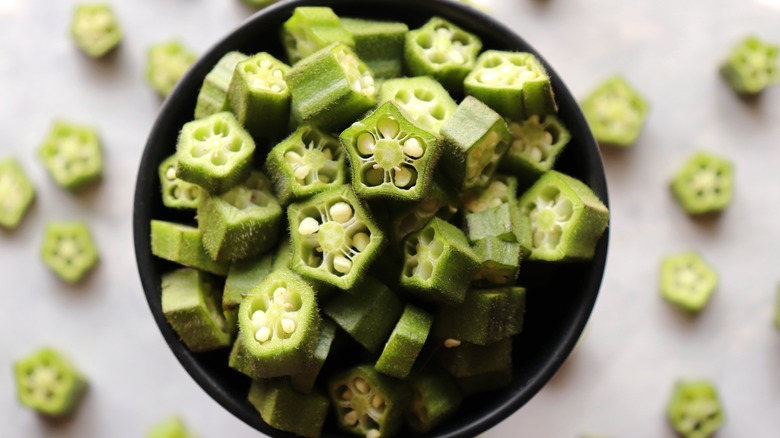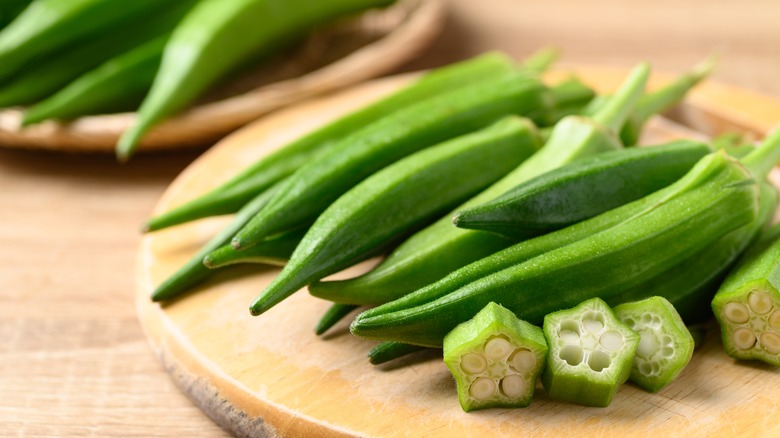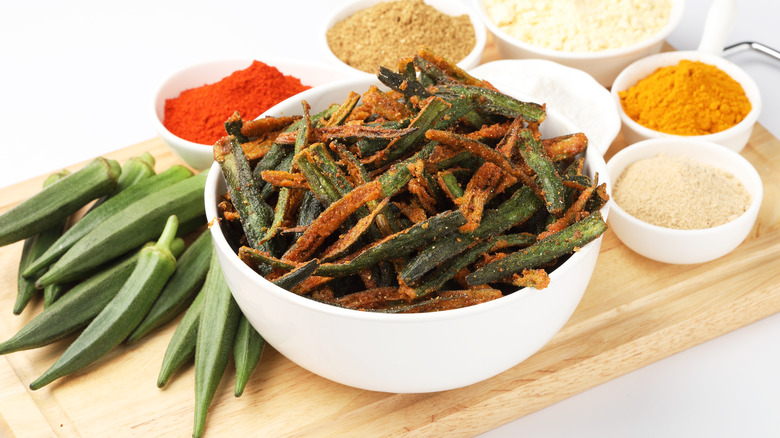Leave Okra Out Overnight For A Texture Transformation
There are two kinds of people in this world: Those who abhor okra and are deterred by its sticky texture, and those who can't find enough reasons to love okra and would cook it every day if they didn't have to deal with the slime hiding inside. Okra slime has a notorious reputation for sticking to everything — whether it's your fingers, a knife, or the chopping board — and lingering long after it's fully cooked. But if it's only this gooey substance that's stopping you from fully appreciating or enjoying the wonderful vegetable, there's a way around it. Luckily, cookbook author and "Fire Masters" judge Devan Rajkumar has the answer.
@chefdevan As far back as I can remember my Mom has been slicing okra and laying it out on trays to dry overnight so it would be less sticky once cooked. She saw my grandmother do this when she was a teenager and has been doing it ever since!Generational knowledge can truly be a gift and blessing 🙏🏾 What is a pro tip in the kitchen you've learned from your parents? #guyana #momscooking #cookingtip #chefs #cookingwithmom #momscookingisthebest
On TikTok, chef Rajkumar has shared the hack that his family has been using for generations, explaining that drying okra is the key to making it less sticky. To do so, take the tops and bottoms off, chop the vegetable into thin slices, and spread the pieces on a tray. Let the slices air dry overnight and you should see considerably less slime the next day, which Rajkumar says helps it cook much better. That being said, this trick isn't the only way to improve okra's texture.
More ways to get rid of okra's sliminess
There are plenty of nifty little tricks that can get rid of okra's stickiness and improve its overall texture, and it all begins with picking out the right produce when you're at the grocery store. Larger fingers of okra tend to have more slime inside them so, as a general rule of thumb, look for smaller and more tender fingers that have a brighter hue and aren't speckled with black spots (another tell-tale sign).
When you're back home, there are more steps to take to prevent excess slime. Exposure to water is one big issue, which is why it's essential to dry okra thoroughly after washing and before slicing it open (water will only steam when cooked and that means more gooey, sticky slime). Heat is another factor — which explains why okra is often cooked quickly using high heat. On the flip side, acid reduces the amount of slime that's released, which is why vinegar baths and the addition of acidic ingredients like tomatoes are advised.
When it's time to prep and cook the veggie, consider slicing it lengthwise rather than chopping it into circular pieces. If you must do the latter, make the slices chunkier to produce less slime than thinner pieces. How you cook the okra and what you cook with it can play a significant role, too. For example, Indian cuisine tends to call for okra that's cooked on its own over high heat before wet ingredients are added. On the flip side, Greek preparations soak okra in a salt and vinegar solution before rinsing off and cooking with tomatoes.
Is okra slime such a bad thing?
Known as mucilage, okra slime is made up of proteins and sugars that are drawn out more in some situations. Though there are ways to make okra less sticky, an important question is whether the slime is so bad in the first place. As it turns out, it isn't! For one, the mucilage is packed with soluble fiber that has a host of possible health benefits, including helping to reduce blood cholesterol and boost immunity (via Consumer Reports).
Additionally, okra slime can be a great advantage in cooking applications, too; it's an excellent thickening agent that can make curries and gumbo more gelatinous. Food scientists have even tested okra's thickening abilities on ice cream, only to find it better than guar gum in some cases. Besides, if you want your okra to be crispy as in a pan-fried okra recipe, you'll want to keep the mucilage — it's a carbohydrate that will dehydrate when exposed to heat and form that desired layer around the veggie.



